Single Leg Reach
How to Do the Beginner Deadlift - Single Leg Balance Reach at Home - No Equipment | In-Depth Guide [VISUAL LEARNERS] Beginner
Proper Form, Common Mistakes, & Variations + Easier | Home Resistance Training
WHAT DO YOU WANT TO SEE?
QUICK DEMO
QUICK DEMO
MUSCLES THIS WORKS
MUSCLES
MAIN MUSCLES WORKED IN the Single Leg Reach
Gluteals (maximus, medius, minimis) & Hamstrings
OTHER MUSCLES WORKED:
- Transverse abdominis
- Erector spinae
- Obliques
- Quadratus lumborum.
- Tensor fascia lata
- Adductor magnus
- Piriformis
- Gemelli
- Obturator
- Quadriceps
- Gracilis
- Adductor brevis
- Longus
- Pectineus
- Gastroc
- Soleus
- Anterior and posterior tibialis
- Peroneals
- Extrinsic and intrinsic muscles of the foot
STARTING POINTERS
Starting Pointers
WHAT WE'RE DOING TODAY
The Single Leg Reach is frequently used in physical therapy as a treatment for ankle, knee, hip, and back pain, injuries, or instability (ie: chronic ankle sprains, and knee pain. This lifting technique is used for teaching how to lift smaller objects from the floor while protecting the back. Mastering this movement will improve core strength and balance so that you will be able to lift more weight with single-leg deadlifts exercises.
This exercise is done standing on one leg and hinging forward at the hip to move the trunk from a vertical to a horizontal position trying to stretch the body parallel to the floor from head to non-working toes. The focus should be on keeping the body still during the movement. The Single Leg reach is a full-body exercise, you are pretty much working the muscles from the neck to the toes. Doing a body scan helps to ensure that you are using the right muscles and keeping everything in the proper place. Starting at the feet and working up to the neck, scan your body, paying attention to alignment and what the muscles are doing.
HOW TO DO THE EXERCISE
LOOKS
HOW THE Single Leg Reach SHAPE OUR BODY
Tones buttocks, thighs, calves and midsection.
PROPER FORM
PROPER FORM: Single Leg Reach
EQUIPMENT, SETS & REPS
EQUIPMENT
None; Bare feet can maximize the use of the foot muscles.
SUGGESTED STARTING WEIGHT FOR WOMEN:
None
SETS & REPS:
8 sets of 10 reps (can be less with a longer hold time).
PACE:
Slow control with an isometric hold of 3-5 seconds in the end position. Work on decreasing the time between reps, strive for fluid motion.
BODY POSITION
BODY POSITION FOR THE Single Leg Reach
FEET: Standing on one leg, knee bent (your body will be lowered by about 2-3 inches). Foot flat on the floor - weight evenly distributed across the ball of your foot and your heel, toes spread. Your other leg should be held down in line with your standing leg, knee bent. Legs not touching.
BODY STANCE: Neutral spine (includes neck) alignment throughout the exercise. Shoulders and hips squared, pelvis level.
ARMS: Relaxed by your sides.
HOW TO DO
HOW TO DO THE Single Leg Reach
CUE: You should feel balanced over your supporting leg. The movement is like a seesaw - as your torso moves down, your lower body comes up.
Hinge at the hip of your standing leg to lean your torso down.
As you lean, push back with your non-working leg. Stretch your arms overhead. Your working leg continues to be mostly straight, with your knee bent to lower your body about 2-3 inches - you should feel your leg muscles working hard to hold you balanced.
Continue until your back leg, torso, and arms are all in one line and parallel to the floor. Check in with your foot and make sure that your weight is still evenly distributed across the ball and heel of your foot, the muscles in your feet - including your toes will be working hard to keep you balanced. If you find your weight is more over the ball of your feet only, think about pushing your body back. Stretch your body out long, energized from your fingers to your toes.
Hold for 3-5 seconds, keeping your pelvis level and your spine neutral.
Using the glutes and hamstrings pull your torso back up to the starting position. As you return to upright standing, bend your non-working knee. Work towards not touching down with your non-working leg between reps. If your toes do touch down, try not to shift your weight onto that side - keep it on your working foot only use your non-working leg to maintain balance. Your non-working knee will bend as your leg comes back in.
HOW TO SAFELY GET OUT OF THE EXERCISE
Return your lifted leg to the floor.
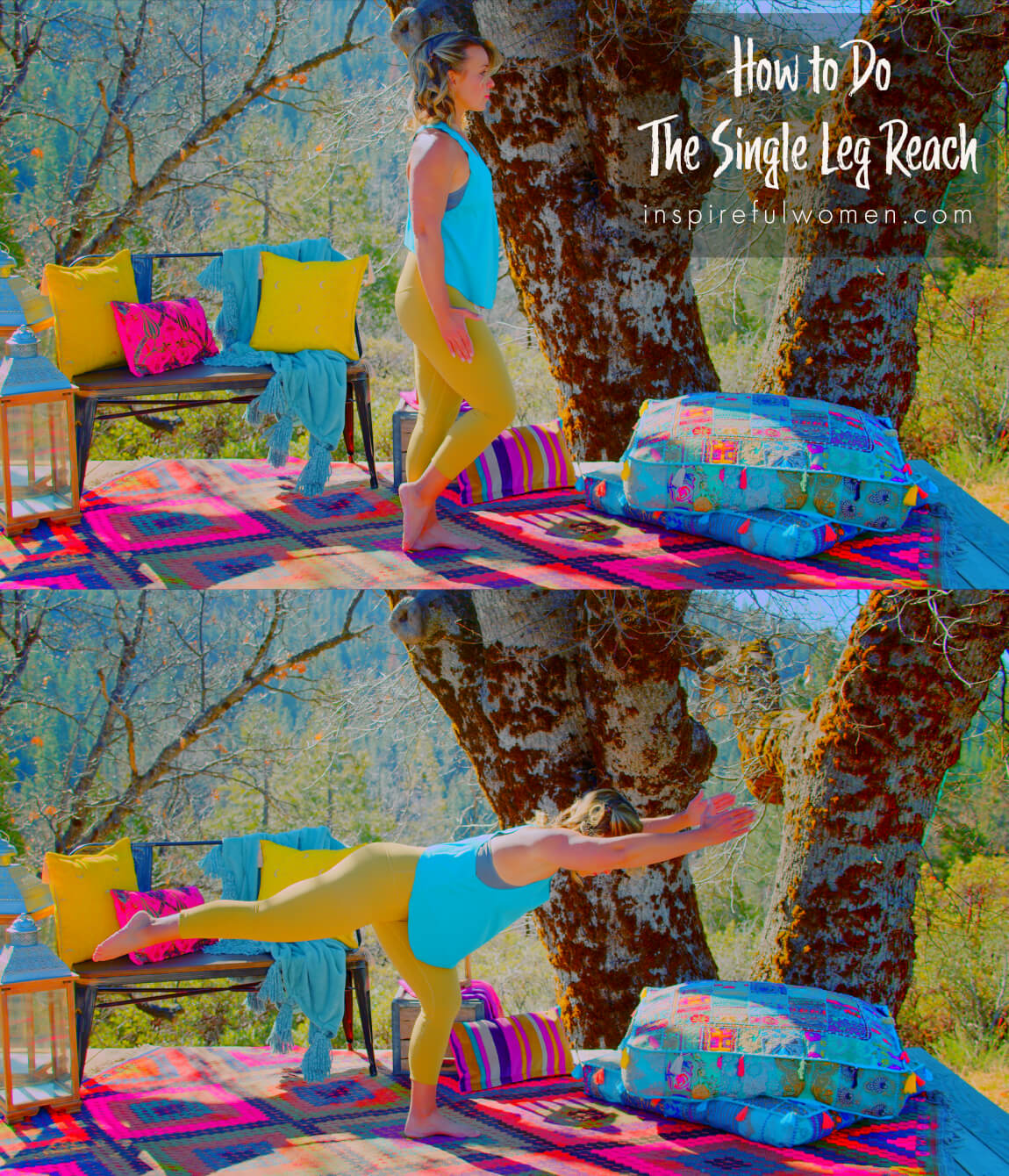
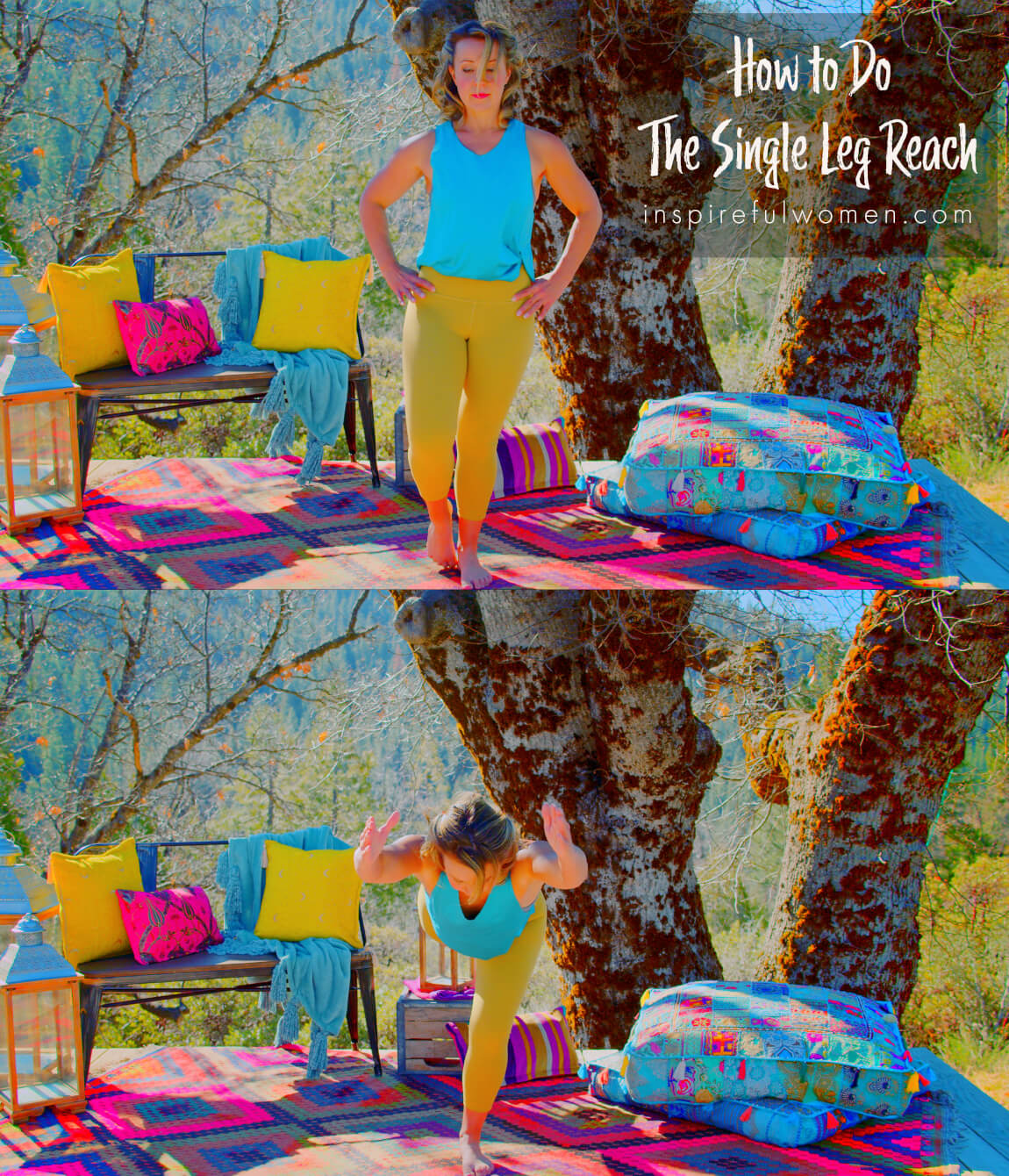
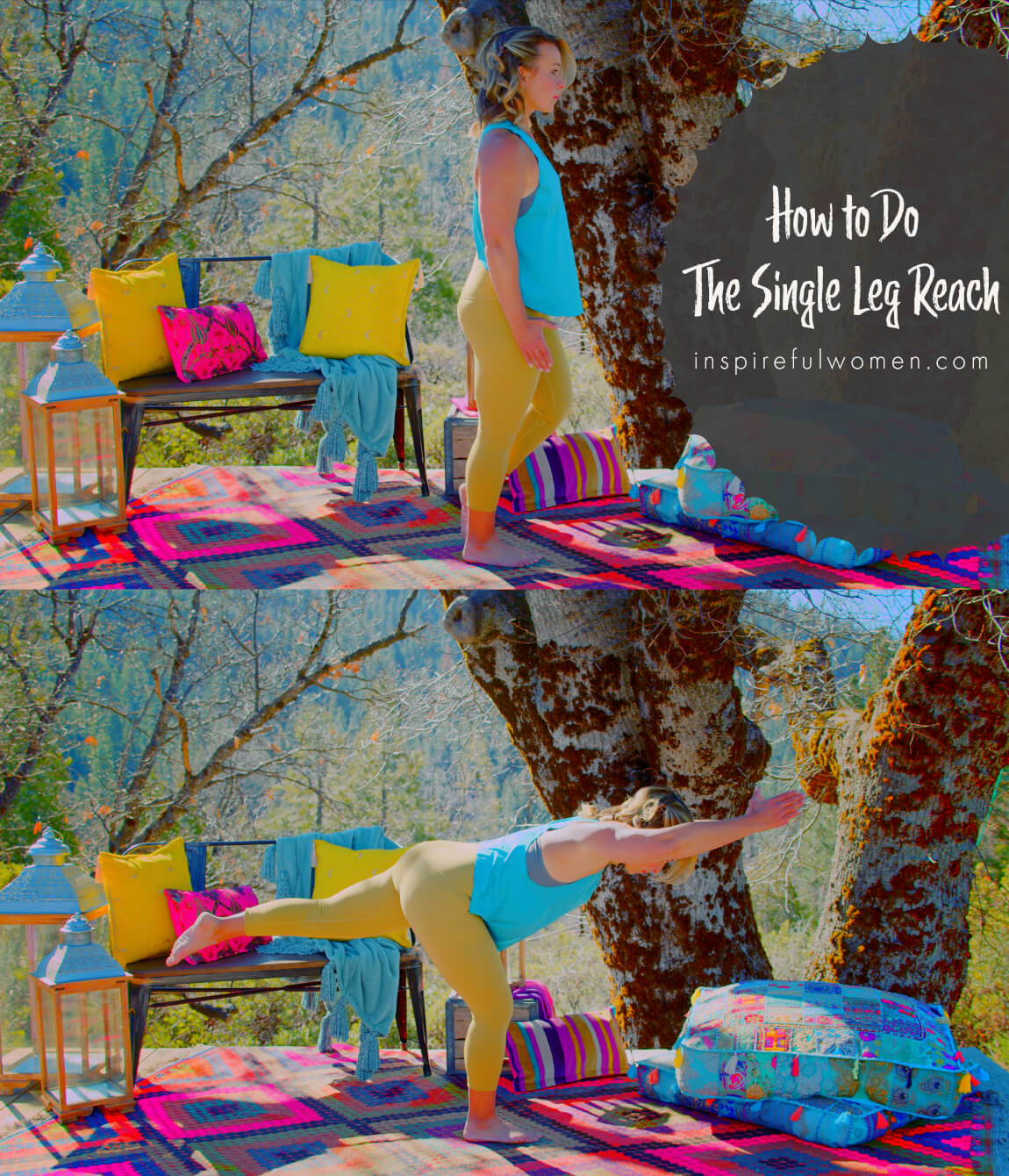
COMMON MISTAKES
COMMON MISTAKES
WHAT TO AVOID WITH THE Single Leg Reach
KEY TIP:
Guess what? Good news! Many avoids are the same for most movements. Once you learn the basics, there's really only a few extra avoids for each individual movement.
1. Avoid Rotating Pelvis
AVOID: Letting the pelvis rotate.
WHY NOT?
- It is common to want to lift the side of the pelvis that is not supported up.
- This happens when you are leaning the torso forward
- This will decrease the muscle activity of the working hip and back.
WHAT TO DO:
- It may help to think about keeping the toes of the foot that is lifted pointed straight down towards the floor.
- The back of your pelvis should be level.
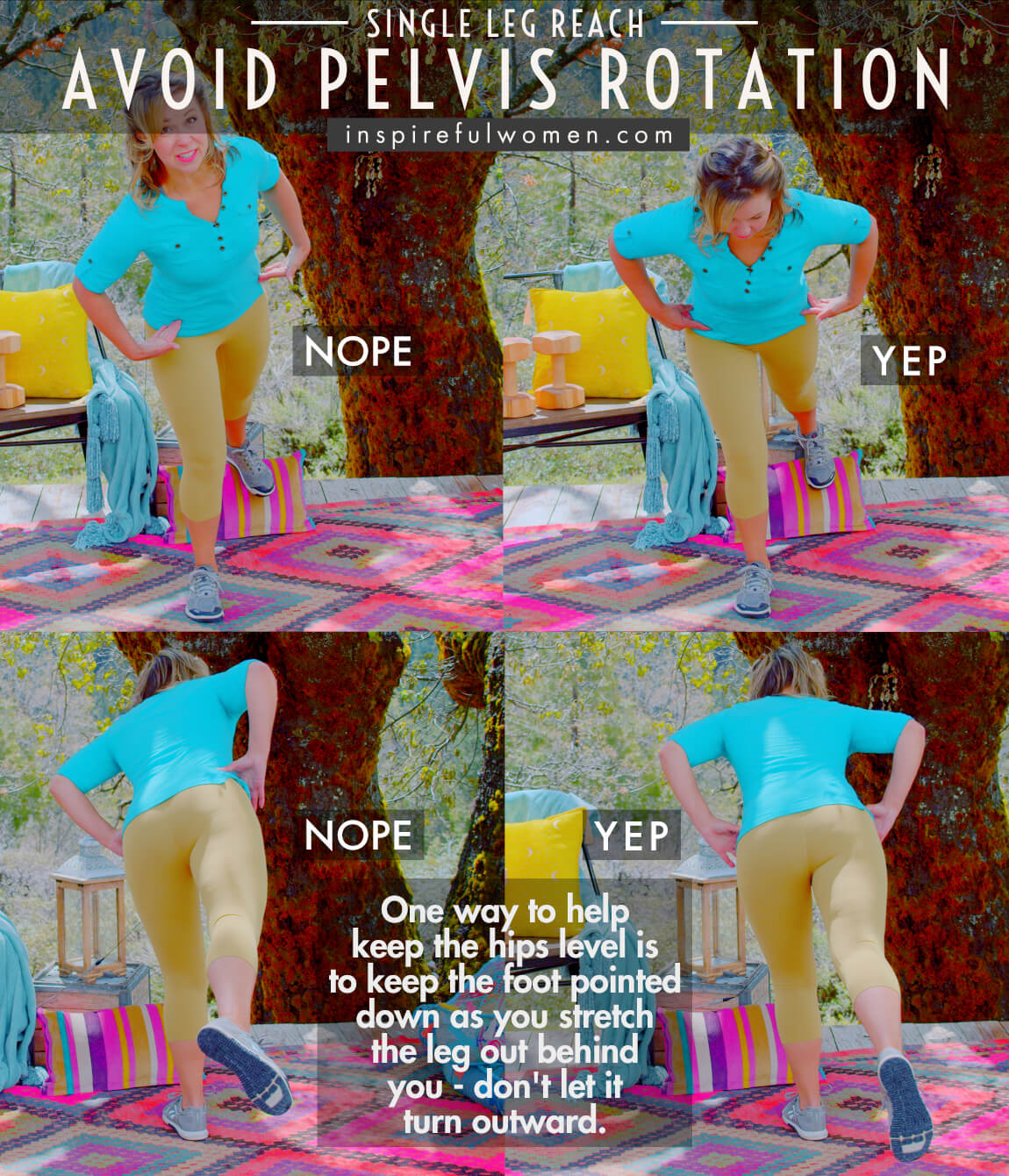
2. Avoid Hip Sagging
AVOID: Letting your the hip on side of the working leg sag or drop.
WHY NOT?
- Could irritate the SI joint (sacroiliac - joint between the sacrum and pelvis) or low back.
WHAT TO DO:
- Keep your pelvis level to work the hip abductors and core muscles to hold the spine and pelvis in neutral.
- If you are having difficulty knowing if you are tilting or rotating your pelvis, try putting your hands around your hips (if you hold your hand in a C shape with your fingertips on your front pelvic bones and your thumbs at the top of your glutes) you should be able to keep the front bones right in line as you move from vertical to horizontal.
- Using a mirror really helps with this.
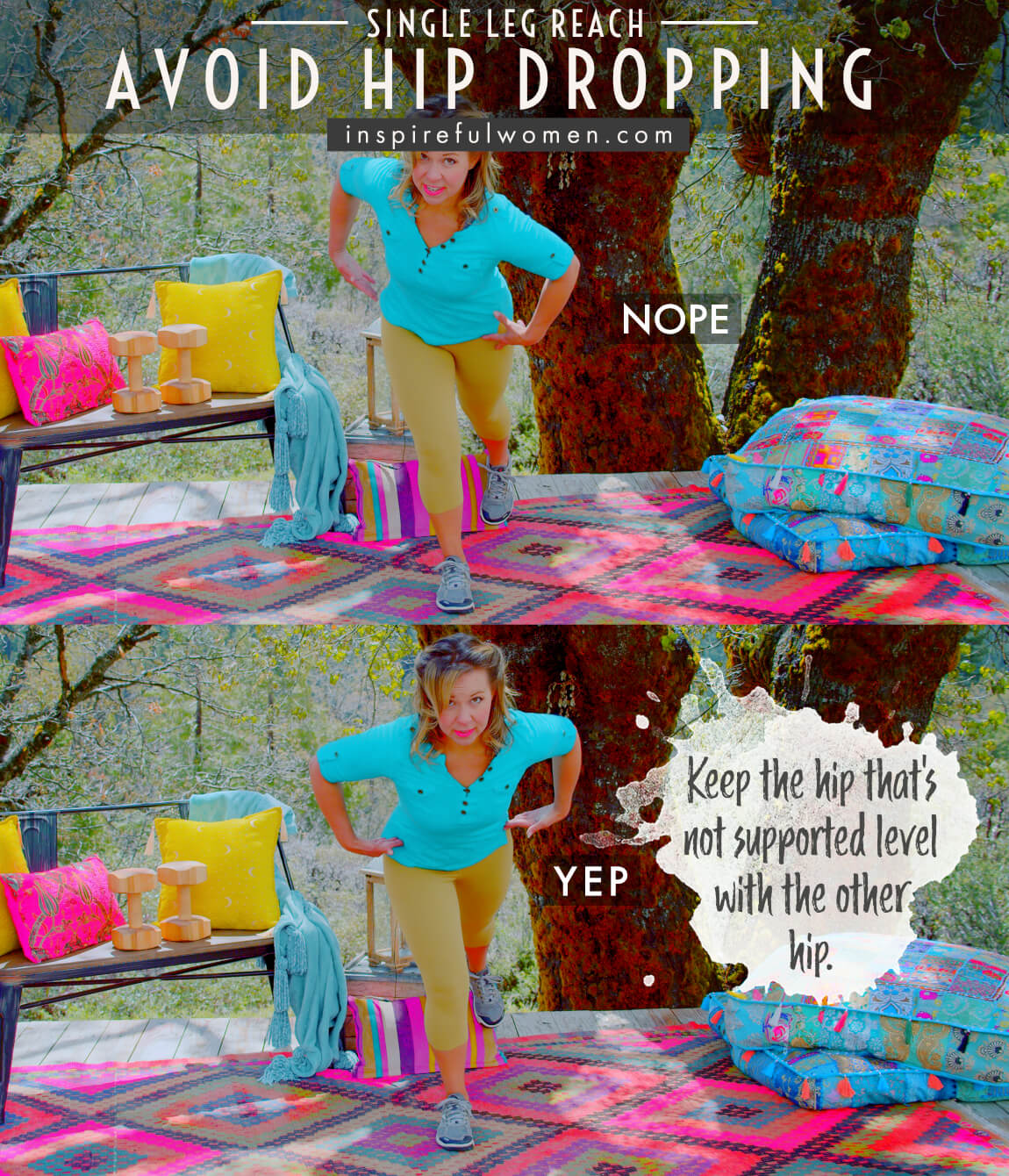
3. Avoid Reaching Forward
AVOID: Reaching forward.
WHY NOT?
- The goal here isn’t to reach forward as it is to send the hips BACK which causes the torso to move DOWN. If you find yourself reaching forward, the dumbbells moving further away from your torso, this will not achieve the right muscle activation & will also put unnecessary strain on your low back.
WHAT TO DO:
- Try to isolate the movement to the hip joint as you lower down and lift up, keeping the arms relaxed and hanging down.
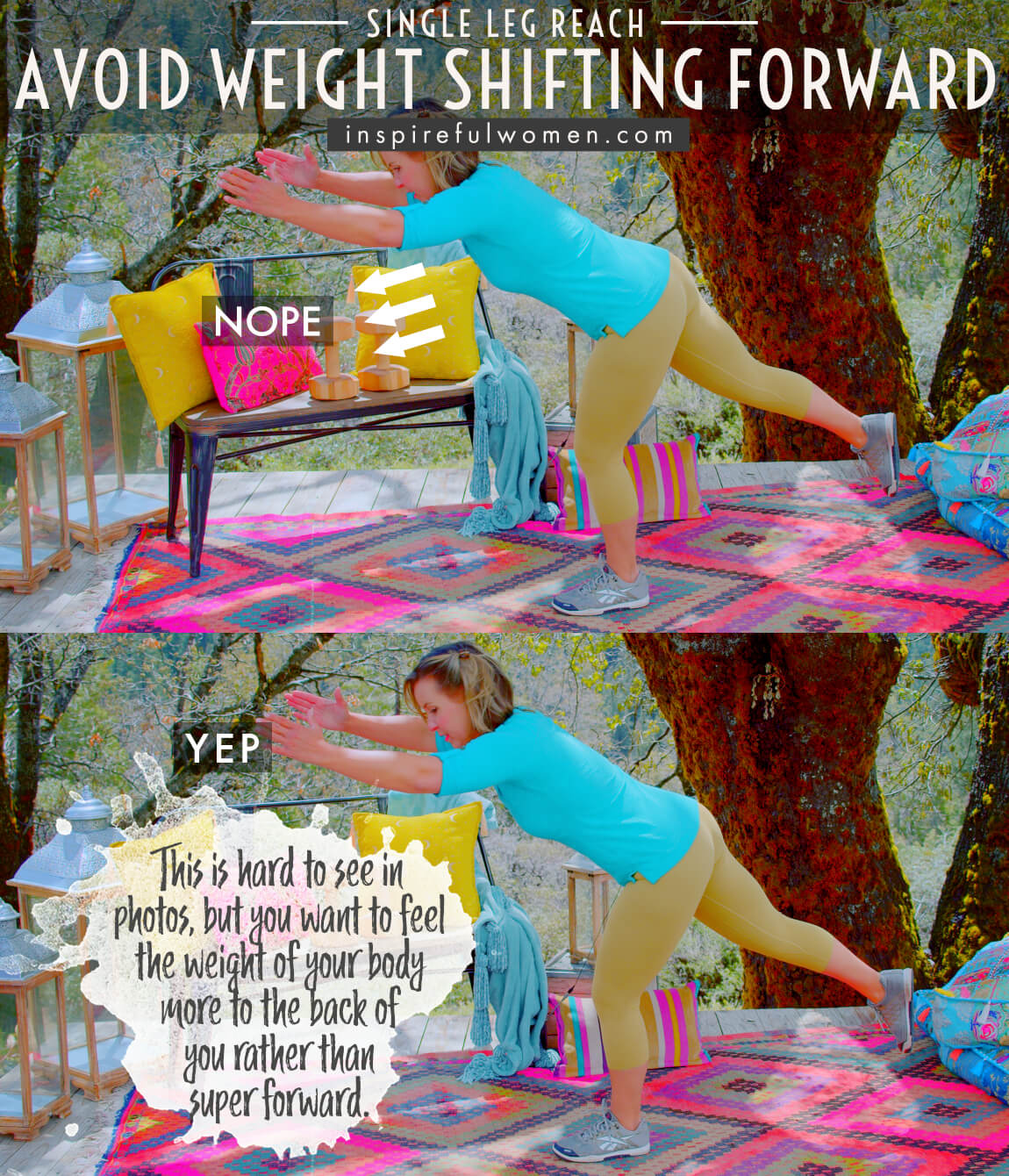
4. Avoid Rounding Spine
AVOID: Rounding the back.
WHY NOT?
- This is mostly just a habit developed from years of using your back to lift.
- This can also happen when you use too much weight.
WHAT TO DO:
- Begin with no weight or lighter weight and just practice your form, add weight slowly.
- Keep your sternum lifted and your abdominals engaged to help keep your spine in neutral.
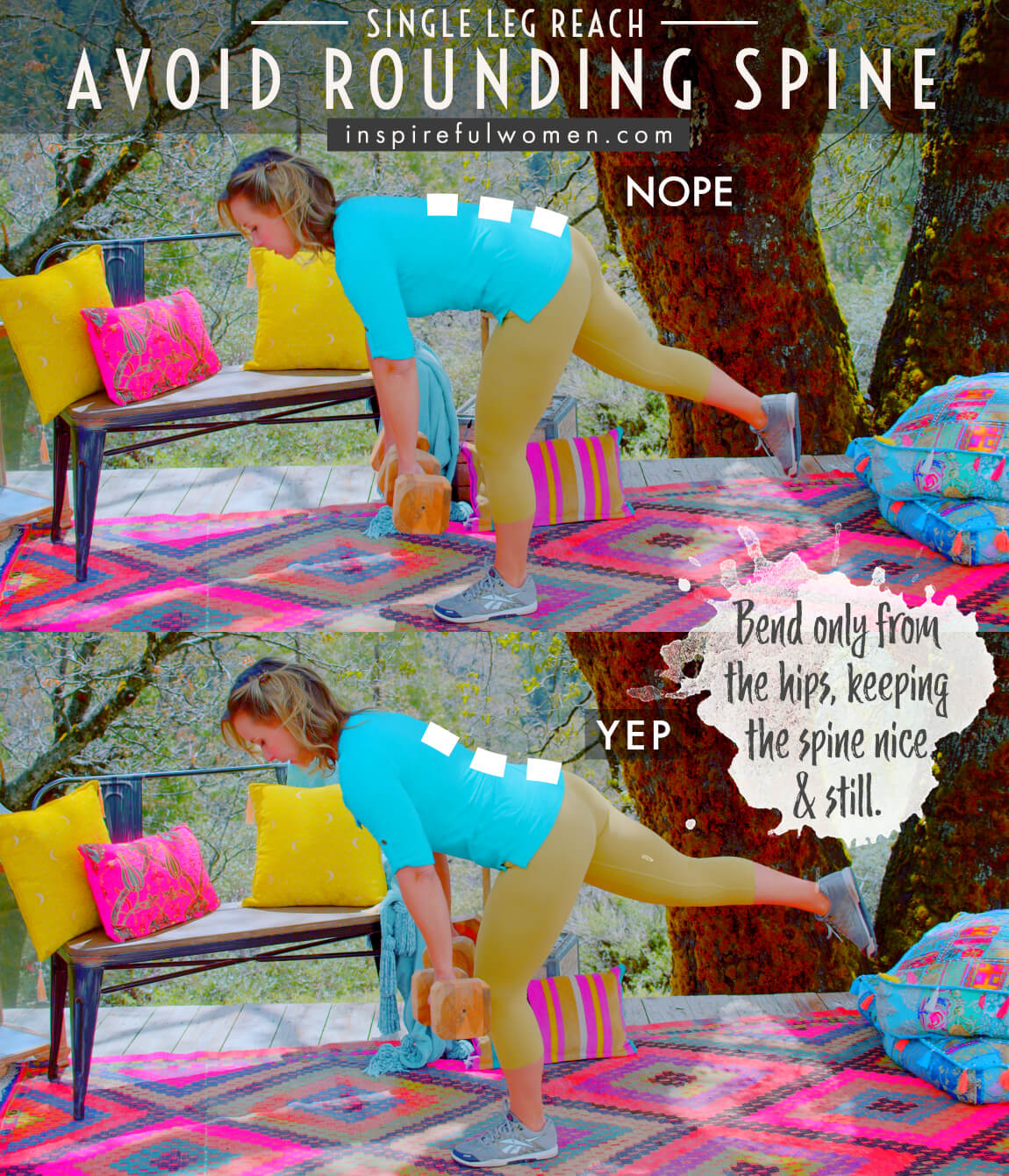
5. Avoid Unsupported Leg Staying Bent
AVOID: Keeping the free leg bent.
WHAT TO DO:
- Straightening the free leg behind you as you lower with the stance leg will actually activate the stance leg hamstrings and glute muscles MORE.
- Energizing the free leg as it reaches back will help with balance and stability.
- Also works the muscles of the free leg more: the quadriceps, hamstrings and gluteus maximus will be more active isometrically.
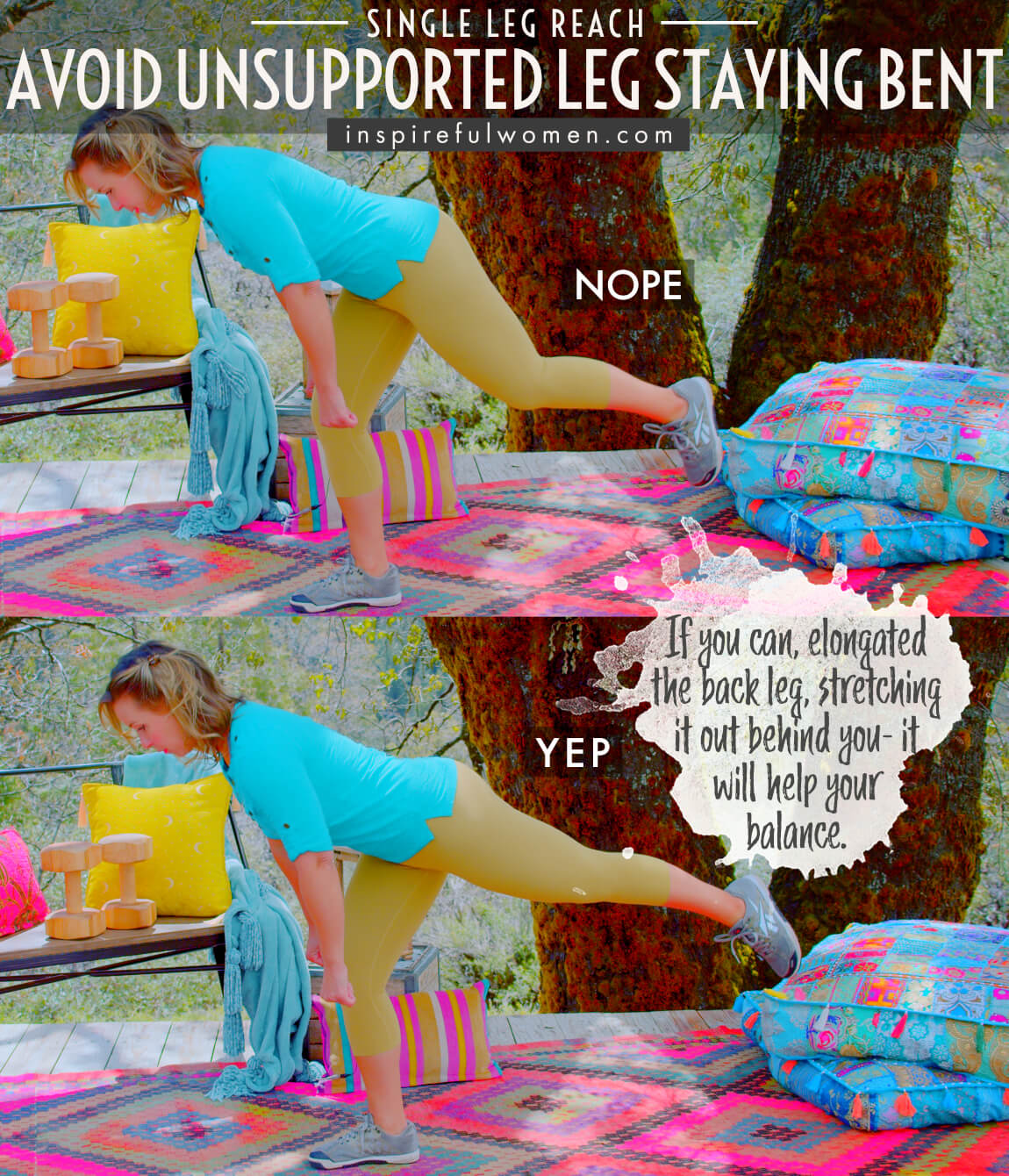
6. Avoid locking knees
AVOID: Straightening or locking the knee of the working leg.
WHY NOT?
- Straightening the knee can make it difficult to maintain a neutral spine.
- Locking the knee increases the forces on the joint surfaces and allows the muscles to relax.
WHAT TO DO:
- Keep the knee soft to protect the knee joint and work the muscles.
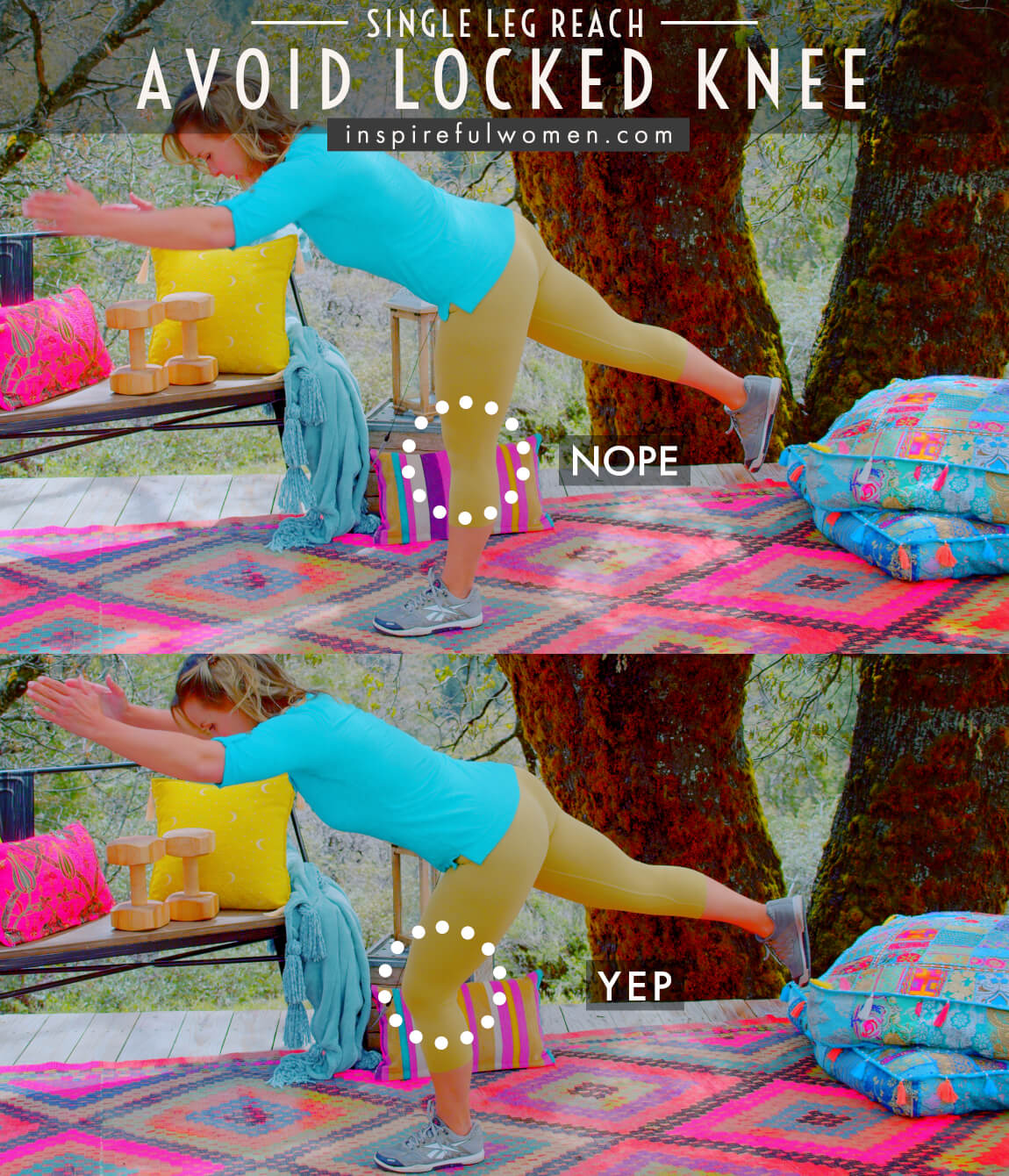
7. Avoid Lifting back leg too high
AVOID: Hinging or lifting the leg too far.
WHY NOT?
- When people lift their legs too far they are usually arching their backs to do so.
- This would defeat one of the goals of the exercise which is to strengthen the back muscles with the spine in neutral.
WHAT TO DO:
- The goal is to have the torso and leg in a straight line - you should be able to draw a line from the ear to the ankle in the end position.
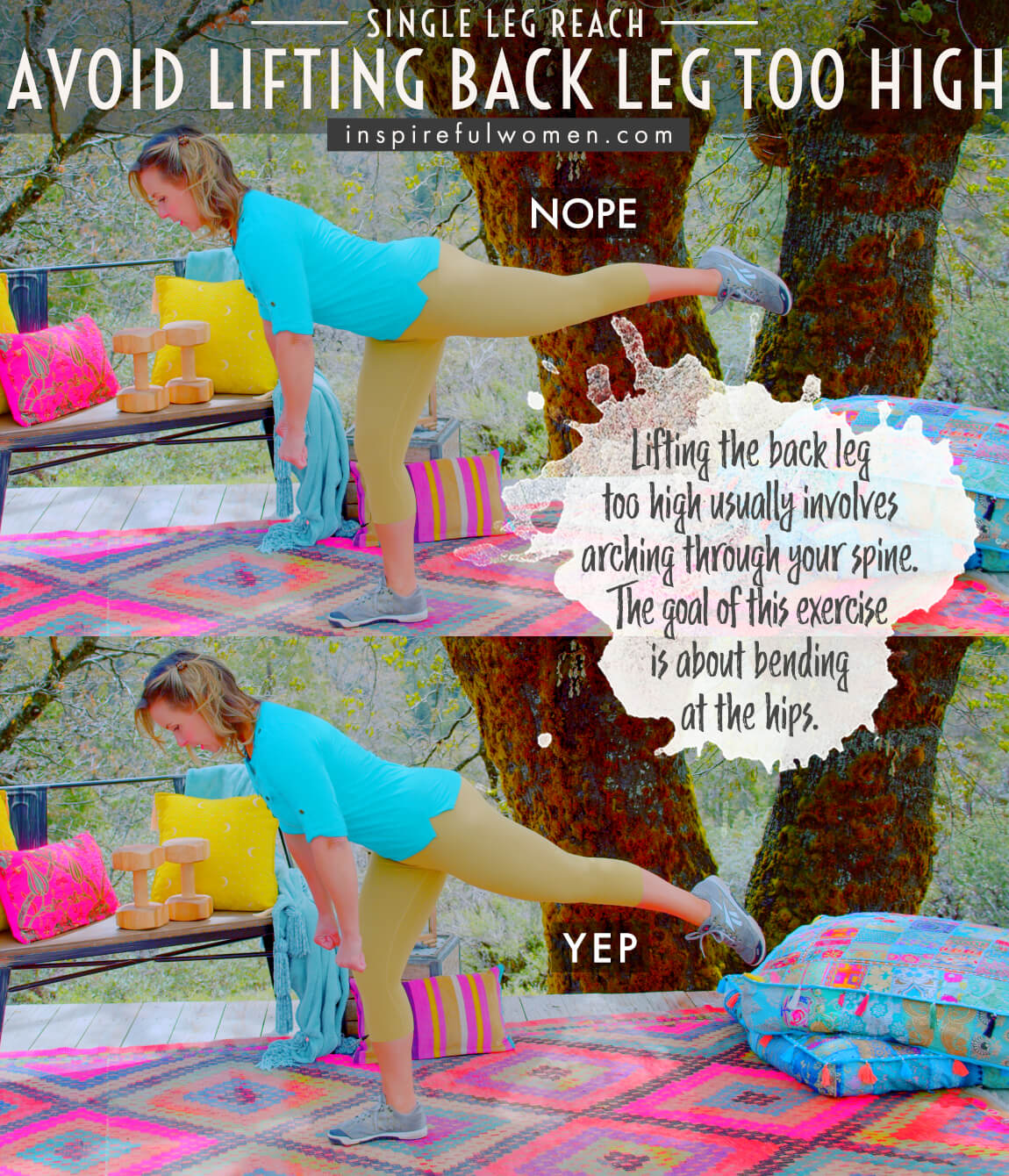
8. Avoid Knees/Feet Caving In or Out
AVOID: Letting the feet or knees lean in or out.
WHAT TO DO:
- Keep the ankles and knees aligned during the exercise to avoid straining the ligaments on the sides of the knee.
- The knees should travel over the second and third toe as you lower down and lift the weight.
- If you struggle with this:
- No resistance - weights or bands should not be added until you can do this movement with proper form.
- If your knee tends to lean in try pushing your little toe down into the floor.
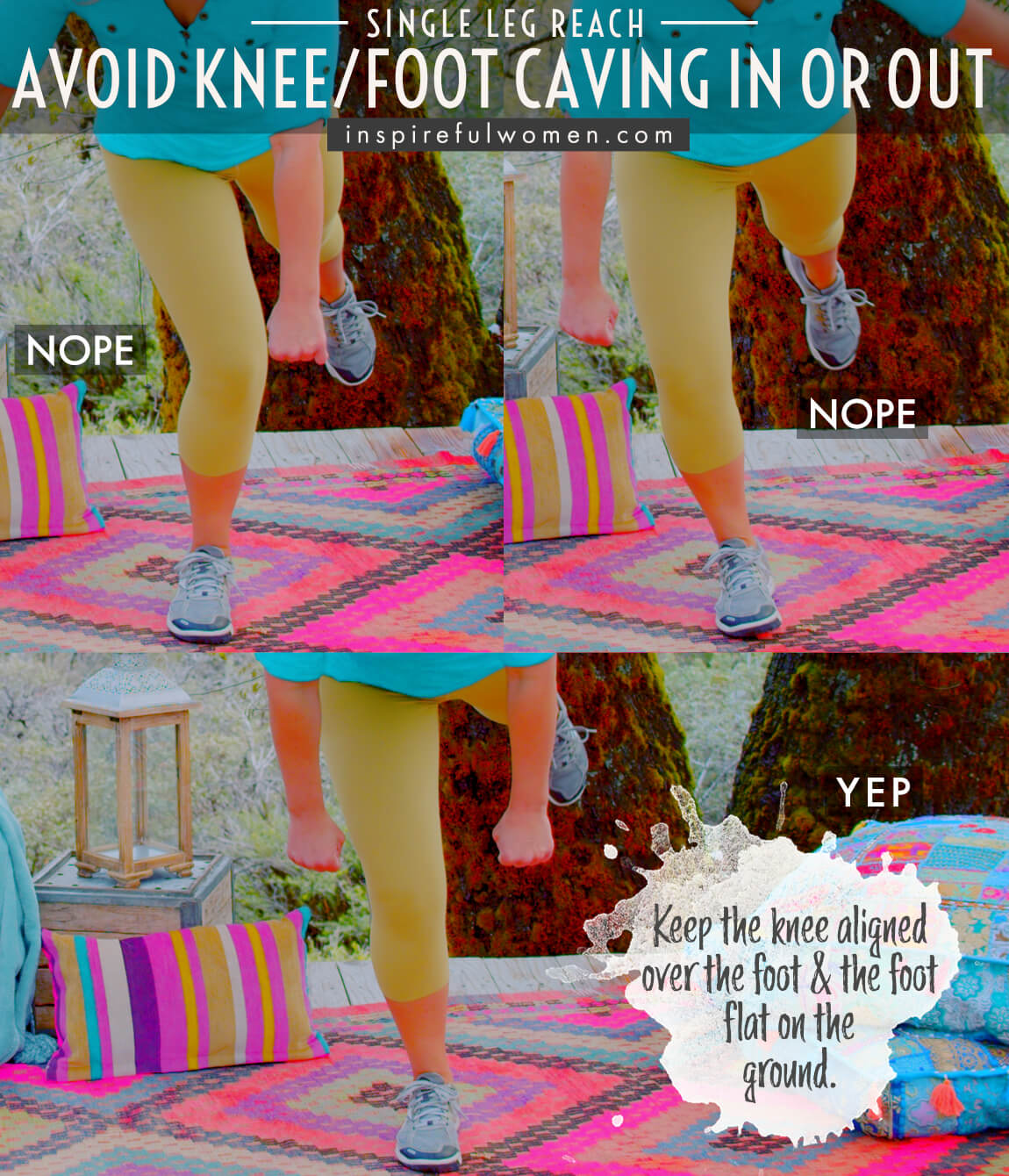
9. Avoid lifting chin
AVOID: Lifting your chin as you hinge.
WHY NOT?
- This can cause neck strain.
- Deadlifts do strengthen the neck muscles when you lean over.
WHAT TO DO:
- Remember that your neck is part of your spine.
- Keep the entire spine in neutral to strengthen the muscles in the healthiest position.
- Looking slightly down during the entire range of motion may help to keep the neck in neutral.
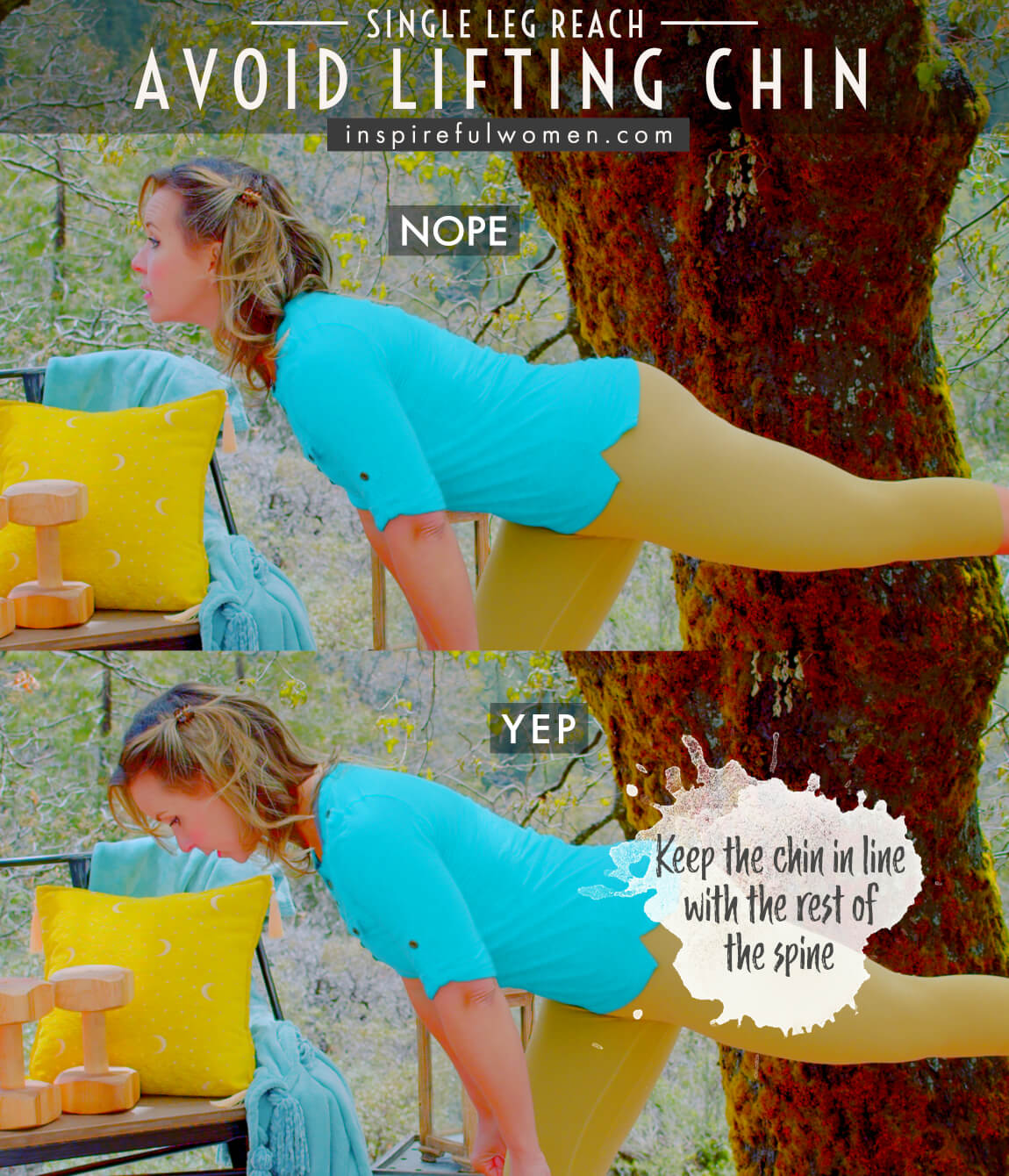
VARIATIONS
VARIATIONS
VARIATIONS OF THE Single Leg Reach
Add Knee Bends
Add a Knee Bends
After hinging forward, in the end position with the leg and arms reaching out, complete 5-10 small knee bends. Only bend down a few inches. This will work the leg muscles more, especially the quadriceps and gluteus maximus. This version works the stabilizing muscles a lot more. When the leg remains more straight, you can almost kind of “lock in” your position which makes it feel a lot easier- the lock home mechanism kicks in when the knee is roughly 20 degrees of flexion to neutral.
By bending the knee, and now being bent at 2 joints a fair amount this position is a lot less stable & requires all the stabilizing muscles that surround these joints (including at the ankles) to work a lot harder to keep your leg aligned & balanced.
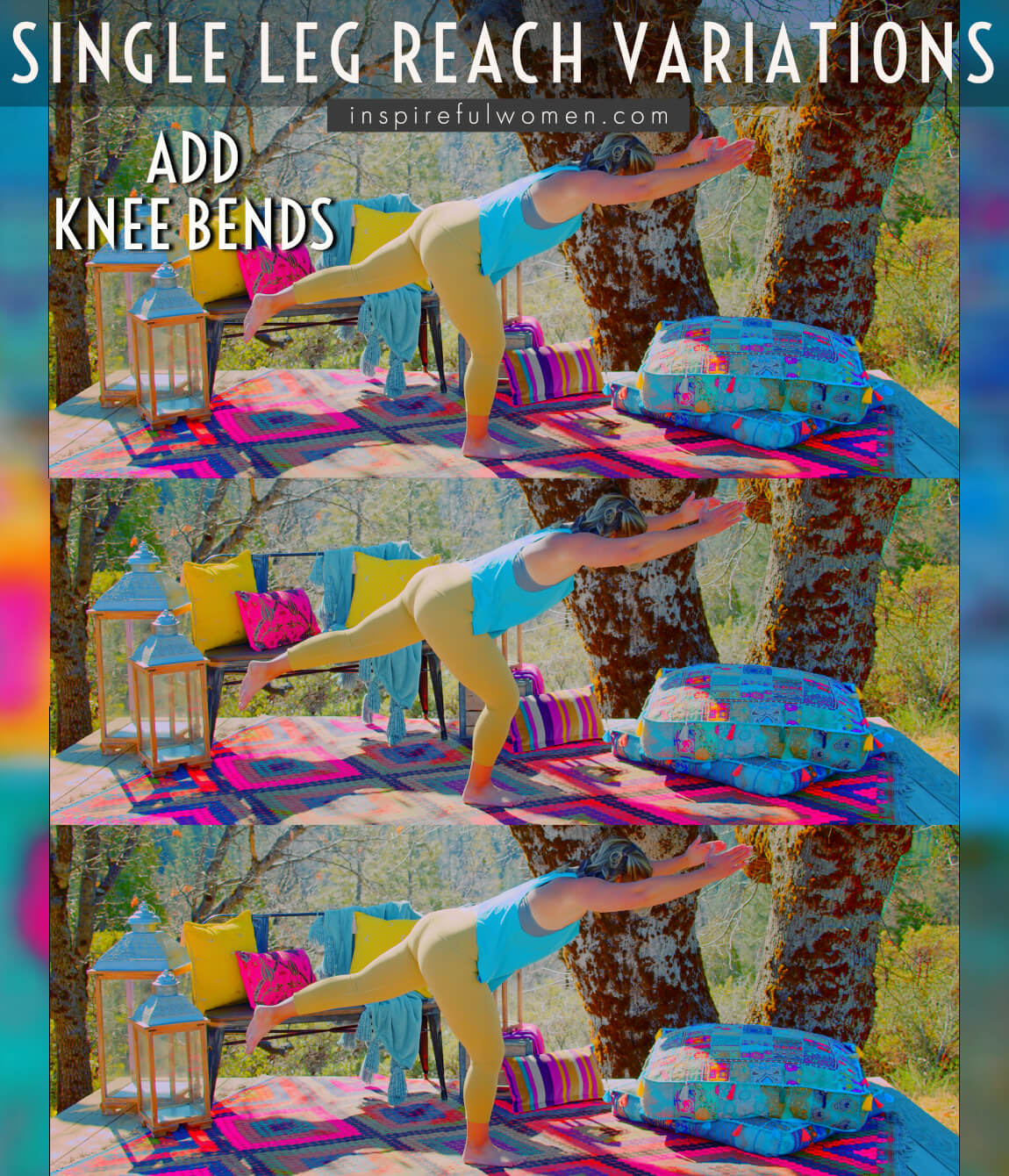
Add Arm Movements
Add Arm Movements
In the hinged position with the leg and arms reaching out - try alternating arms by leaving one arm in place and bringing the other arm back down beside the hip. Continue moving the arms - with one moving forward as the other is moving back while you hold the position. Any movement of the arms will throw your balance off, the muscles of the feet, legs, and torso will have to make tiny and coordinated changes to their activity to keep you balanced. The faster the arms move, the harder it will be.
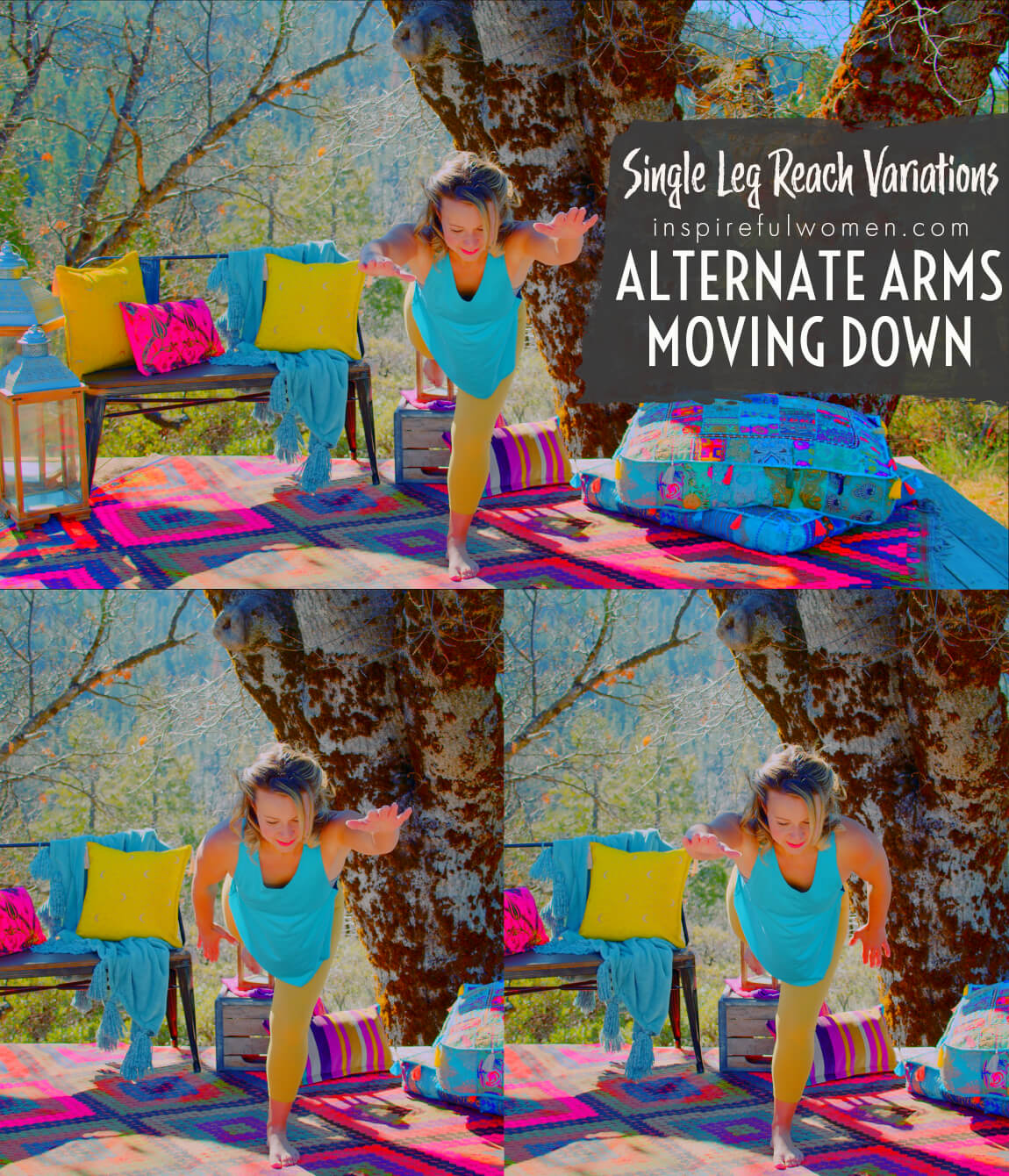
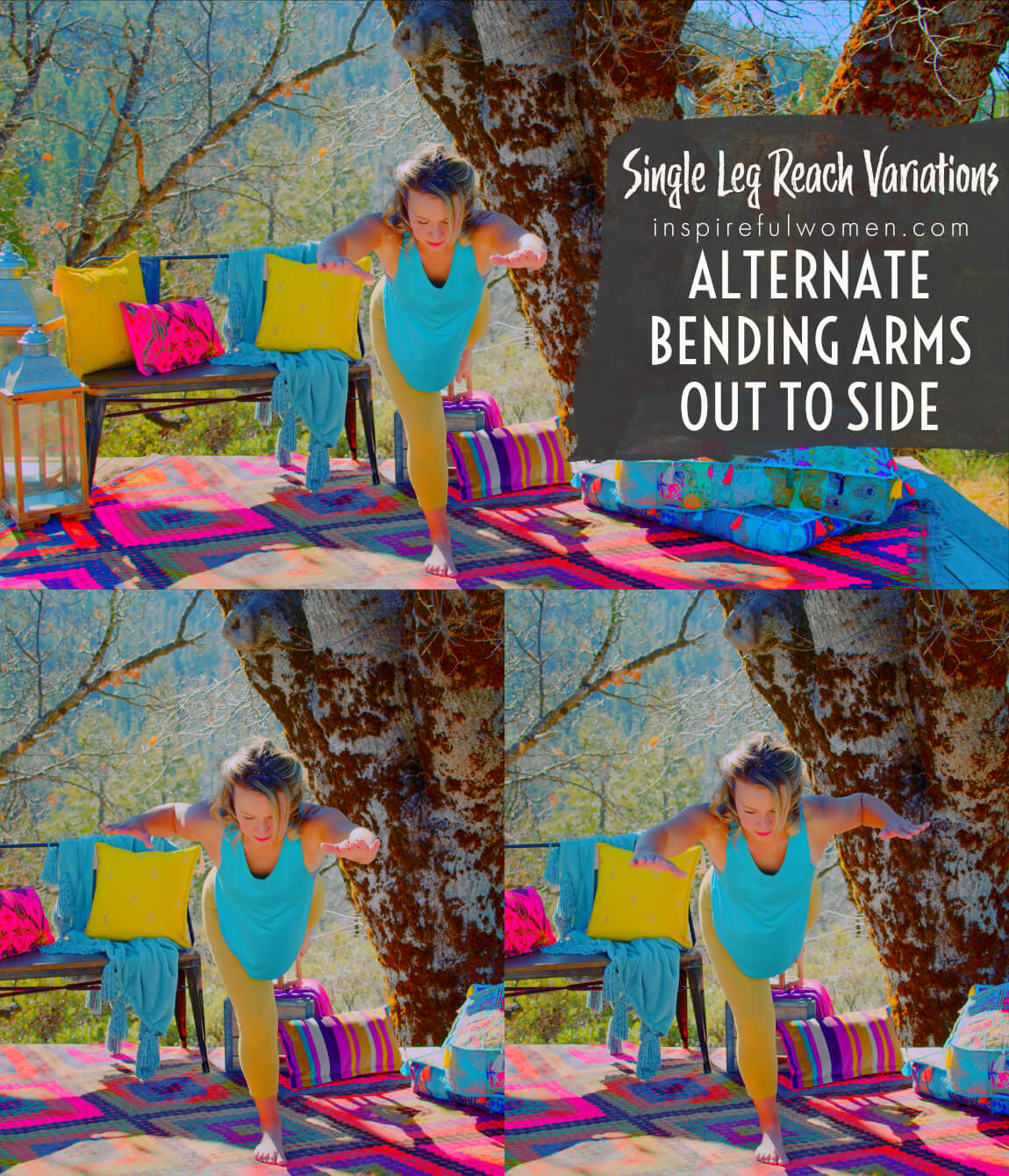
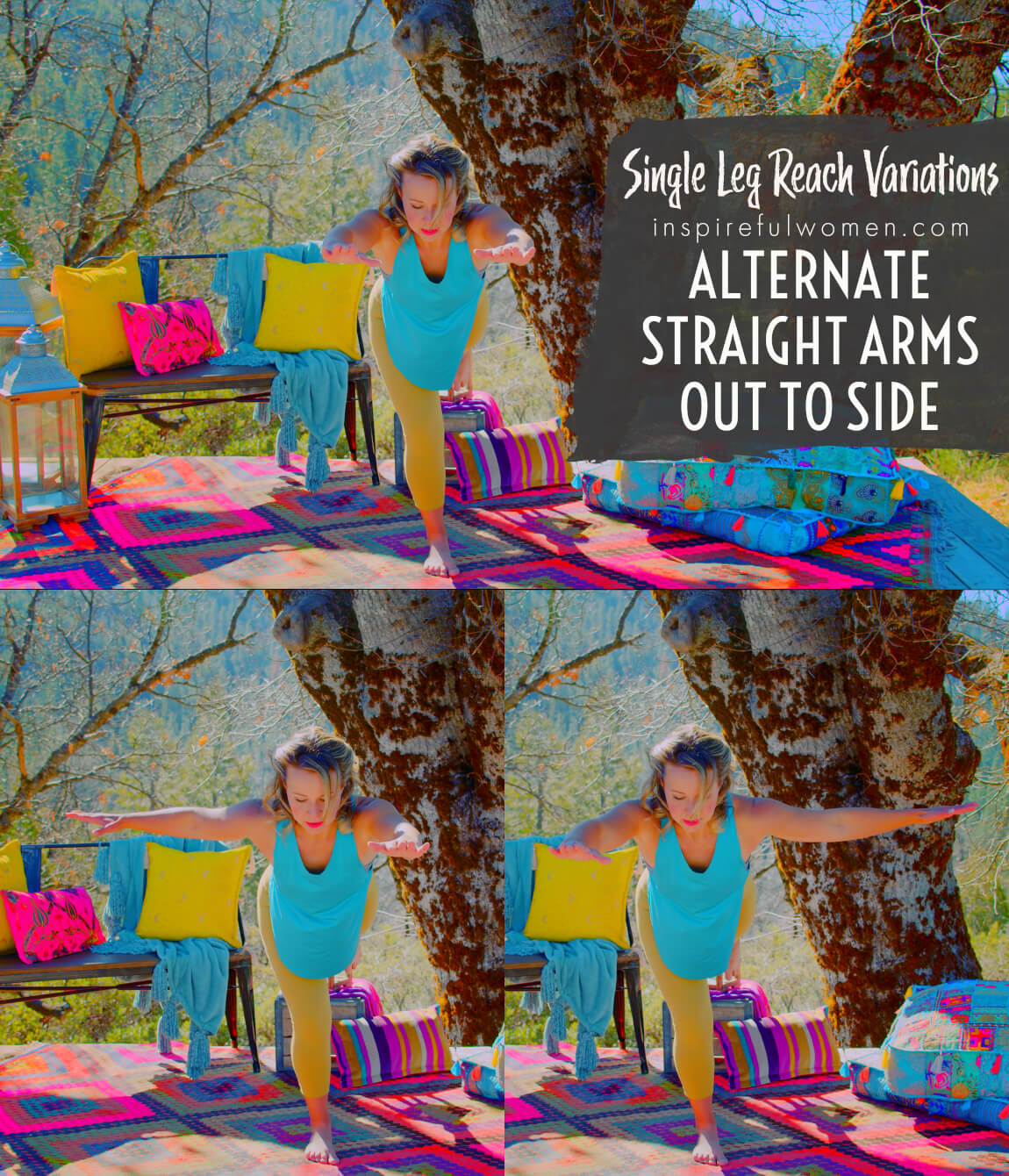
Band for Anti-Rotation
ANTI-ROTATION WITH BAND
This variation uses an anchored band. Anchor a band at hip level. The resistance should be light. Stand sideways to the band, with the band on the side opposite of the working leg for rotations towards the working side. The band is in line with or slightly behind (closer to hips) where your outstretched hand will be when you are leaning over parallel to the floor. Hold the band in both hands clasped together (or in one hand if that is more comfortable). The band will put a rotational force on the body and the hip muscles will have to work to keep the body from rotating. If the body is being pulled towards the working leg, in order for the body to stay still the internal rotators of the hip have to hold the femur still- this is done by the gracilis, tensor fascia latae, gluteus minimus, semitendinosus, semimembranosus.
When the body is pulled away from the working leg, the external rotators, the obturators, piriformis, gluteus medius, gemelli, quadratus femoris, and biceps femoris work to hold the femur in neutral.
This will also work the obliques and quadratus lumborum more to prevent side bending and rotation.
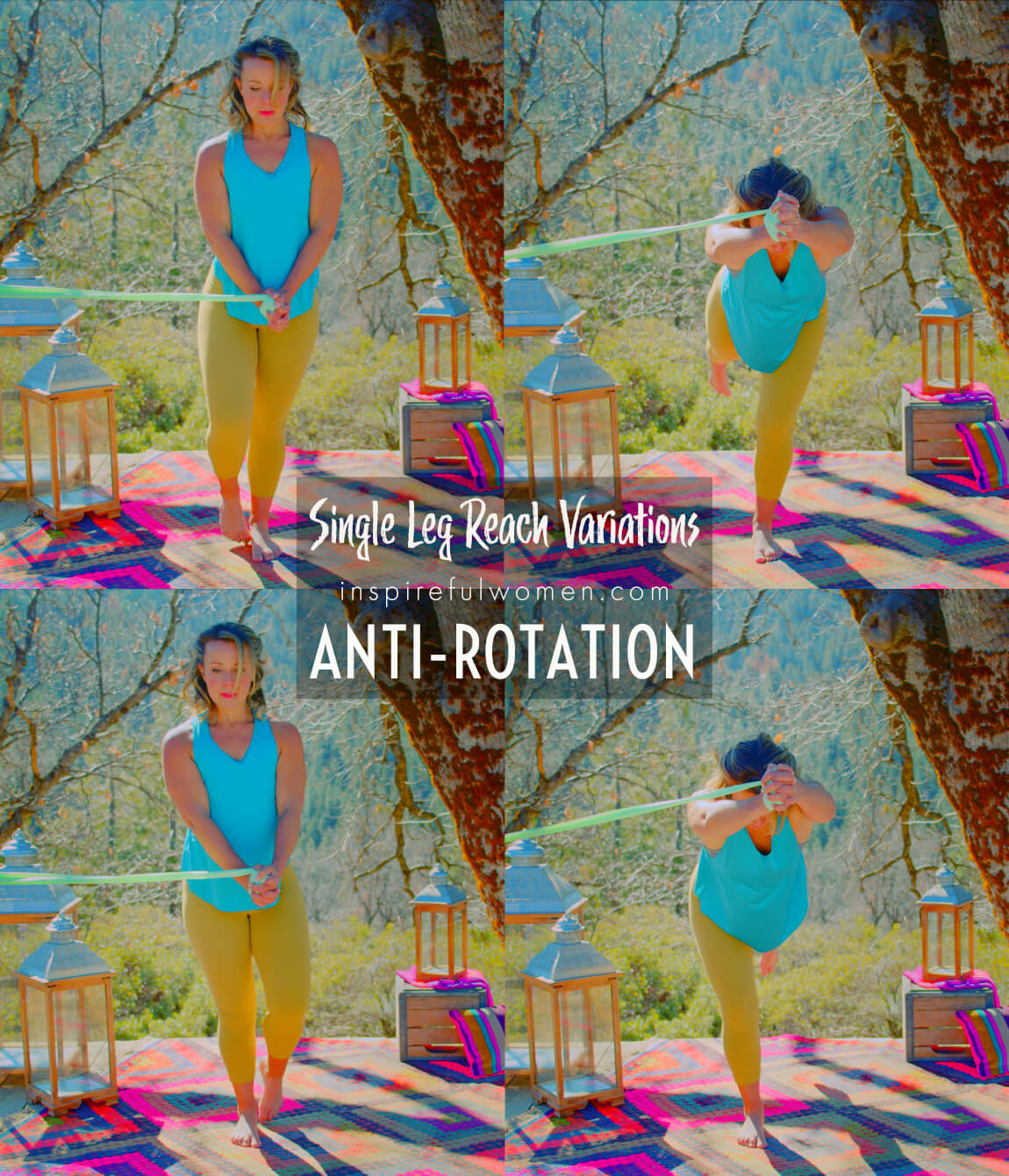
MAKE IT EASIER
EASIER
MAKE THE Single Leg Reach MORE DOABLE
Staggered Kickstand Stance
Staggered Stance
If you are struggling to keep your balance try leaving the “non-working” leg on the floor. Start in a staggered stance, with the toes of the back leg planted on the floor. As your balance improves, try to rely less and less on the back leg to help stabilize and balance the body. Moving the leg in closer means more time standing without assistance from the other leg. Also, when the legs are closer your center of balance will be smaller. Avoid shifting weight to the assisting leg, which will make it harder to balance on the supporting leg.
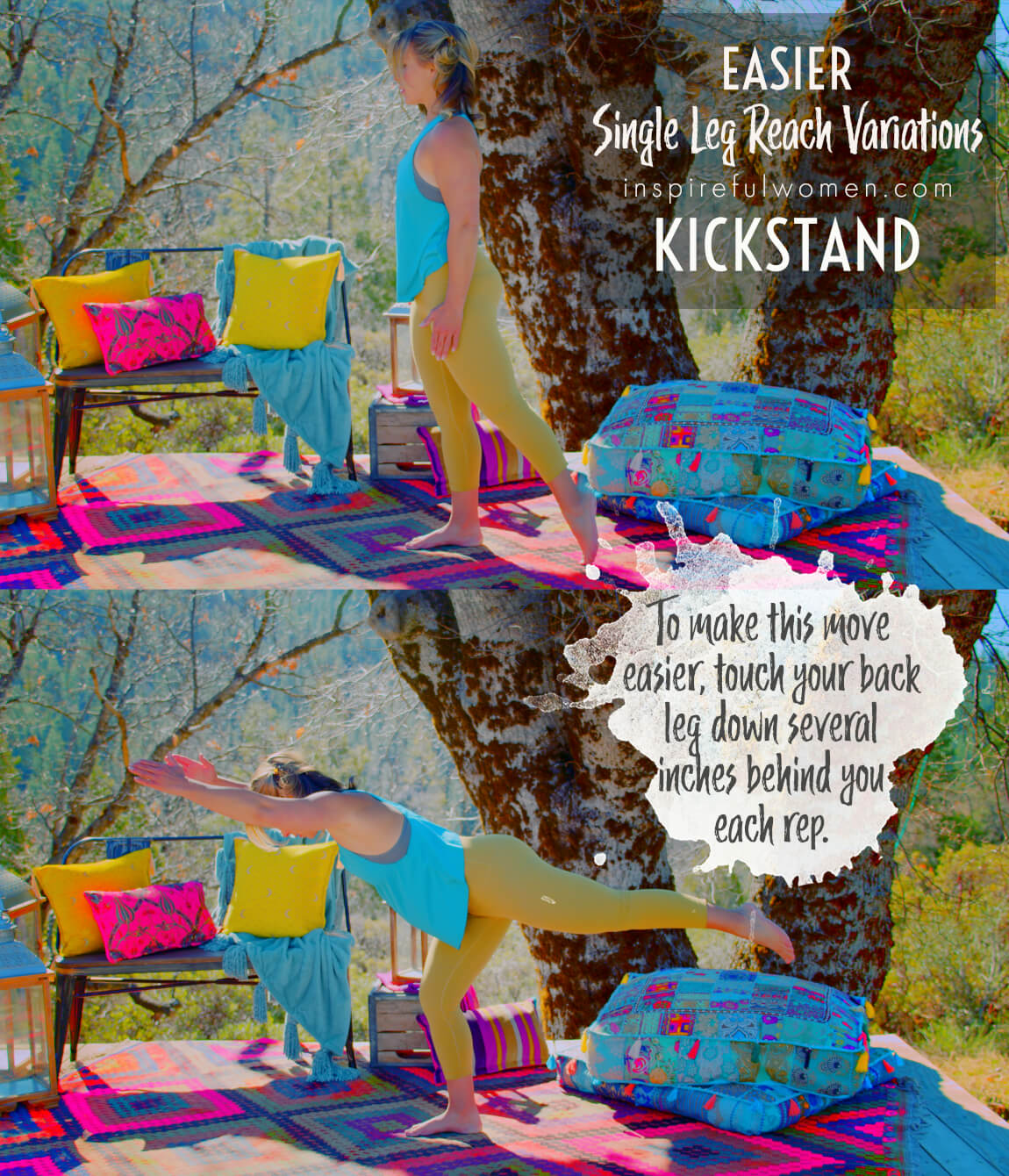
WHAT WE'RE DOING TODAY
WHAT & WHY
BENEFITS OF TRAINING THE Glute muscles
WHAT
3 AWESOME THINGS ABOUT SINGLE LEG DEADLIFTS:
- Single-leg lifts are full-body exercises. They work the muscles from foot to neck.
- They are great for balance and stability, and…
- they are very functional. Will discuss how in the “why” portion.
These exercises are all done standing on one leg. The spine is held in a neutral position - no bending forward, backward, sideways, or rotating of our spine- it stays perfectly still- we are leaning over only from the hip joint.
The exercise is done by leaning the body forward by moving at the hip and lifting the leg out to the back. If done correctly you should be able to feel the muscles of the feet, ankles, and lower leg all the way up to the neck muscles getting involved. As you lean forward gravity pulls the torso down and the leg and back muscles work to stabilize the body. To return to standing the gluteus muscle and hamstrings work to pull the torso back up.
The focus of the exercise is on balance and stability. These exercises are definitely a good workout for the legs but try to avoid the temptation to use more resistance if you cannot keep good form and maintain stability and balance. The exercise can be progressed by adding resistance, either by lifting a weight or using a resistance band to challenge the muscles in a variety of different ways.
WHY BOTHER DOING IT?
WHY
WHY DO WE EVEN CARE?
FUNCTIONAL
Single leg lifts are very functional exercises. They work the muscles of the legs, torso (even the neck) and depending on which version you are doing, they can help strengthen the arms.
IMPROVE LEG STRENGTH
One of the many great things about single leg exercises is that just by lifting one leg off of the floor you immediately double the load that the muscles have to move. Considering the “load” in this case is primarily the weight of everything from the hips up, that is pretty significant. To put it numbers - the upper body/head and arms make up approximately 70% of your body weight. A 160-pound person would be lifting about 112 pounds without any added resistance, each leg would be lifting about 56 pounds. In a single leg deadlift one leg would be lifting the entire 112 pounds! This is a really good way to overload the muscle without the need for large dumbbells. If you have a stronger leg, it is pretty common for that leg to try to do most of the work in double leg exercises. Working one leg at a time is a good way to make sure each leg is working.
TRAIN HEALTHY MOVEMENT PATTERNS
This movement teaches fundamental movement patterns that help keep the joints of the feet and legs healthy and protect the spine from injury. Single leg lifts are done by keeping the spine in a neutral position and moving through the large hip joint. This is the way the body is designed to work - the spine provides a stable base and the movement happens at the large joints that move a lot - like the shoulders and hips.
TRAIN MUSCLES TO STABILIZE JOINTS
Another big benefit of these exercises is that they train the muscles that surround the ankles, knees, and standing hip to stabilize the joint. When these joints move too much (sloppy, uncoordinated movement) the surface of the joints can become worn - this is what is commonly referred to as “wear and tear” on the joints. An important job of the muscles is to work together to stabilize the joint as it supports the weight of the body and as it moves, this is important to help absorb the impact on the joints and to keep them properly aligned so that they can move without damaging the soft tissues. Knee and ankle laxity (too much movement) can strain the ligaments of the joints. Many people with a history of ankle sprains may have been told that they have “weak” ankles. Including single-leg exercises is a great way to strengthen the muscles that stabilize the ankles.
STRENGTHEN FOOT MUSCLES!
All single-leg exercises help to strengthen the muscles of the feet. The feet are extremely important for maintaining balance and stability There are 29 muscles that participate in the movement of the foot - 10 of these originate on the lower leg (extrinsic muscles) and 19 of them are completely in the foot (intrinsic muscles). The foot has 26 bones and 30 joints in it, it is designed for movement - tiny, precise movement that absorbs impact when we walk and helps to control balance and stability. If you are doing single leg lifts with no weight or light weight it is beneficial to do the exercises barefoot. Shoes tend to support and stabilize the foot so that the muscles don’t have to work as much.
When you do single leg exercises all of your body’s weight is on one leg. I know that this is an obvious statement - but it always amazes me that my entire body weight is being supported on one foot. The muscles and joints of the foot and ankle need to be very healthy to hold that much weight. The increased weight bearing on one leg for a longer period of time (for the entire set), is a good way to build bone mass in the legs and hips.
WORK THE SMALLER GLUTE MUSCLES ON THE SIDES OF THE HIPS
Single-leg exercises also work the lesser-known gluteus medius and minimus muscles. You may be familiar with these muscles and their role in lifting the leg out to the side. But, their primary function is actually to keep the hip and pelvis aligned when you are standing up. Keeping the pelvis properly positioned is important for the health of your low back and keeping the hip correctly positioned in the socket is essential not only for the health of the hip joint but also the knee, ankle and foot. Misalignment of the pelvis and hip can affect the joints above and below the area. It is not uncommon for knee, ankle, or foot pain to be caused by poor hip joint function.
IMPROVE BALANCE
With age, our ability to balance naturally decreases. Including exercises to work on balance helps to slow or prevent this decline. It is important for people of all ages to include some balance training - this can be done every day, but at a minimum should be done 3-5 times a week. All balance exercises help to train proprioception - this is the brain’s awareness of where the body is in space.
EVERYDAY LIFE
EVERYDAY LIFE &
MUSCLE FUNCTION
HOW WE USE OUR GluteS Max & hamstrings IN EVERYDAY LIFE
Gluteus Maximus & Hamstrings:
1. STRAIGHTENING (EXTENSION) THE HIPS AND KNEES
- Standing from a sitting position
- Walking up stairs
- Lifting an item off of the floor
- Climbing a ladder
- Walking uphill
- Getting up from the floor
Gluteus Medius, Knee, and Ankle Stabilizers:
1. STABILIZING THE PELVIS, HIPS, KNEES AND ANKLES
- Standing
- Walking
- Up and down stairs
- Running
- Keeping us balanced during all standing and moving
2. MAINTAINING HEALTHY ALIGNMENT OF THE PELVIS, HIP, KNEE, ANKLE AND FOOT
- All static (no movement) and movement
SCIENCY STUFF
SCIENCY STUFF
SPIFFILICIOUS FACTS ABOUT MUSCLES & MOVES
One of the great benefits of single-leg training is that they work all of the small muscles of the ankle and foot. This is a commonly overlooked muscle group that is critical to address. Weak muscles of the ankle and foot can lead to ankle sprains, plantar fasciitis, Achilles tendinopathies, bone spurs, bunions, etc. This is especially the case when the individual trains the larger muscles of the legs - they create an imbalance between the capability of the leg and that of the ankle and foot.
The stability of the knee is very dependent on the ligaments, cartilage, meniscus, and iliotibial band. When these tissues have been strained, torn, or worn (as in the case of osteoarthritis) the muscles that cross the knee joint are called in to help. The same is true for the ankle. When people have feet that tend to pronate (roll in) or supinate (roll out) it stresses the ligaments of the ankle and will affect the alignment of the ankle, knee, and hips. Over time this can result in damage to the joints, and changes in muscle function (because the muscles are not properly aligned so they are not able to move like they are supposed to. A good example of this is the Achilles tendon. Poor alignment of the foot or ankle can cause tightness in the Achilles tendon.
These single-leg exercises challenge the hip extensors and abductors by working them in the sagittal and frontal planes. The movement trains the abductors of the hip to stabilize while the extensors move the weight of the trunk from 90 degrees of flexion to a neutral position. This exercise works on the hip range of motion and movement while stabilizing the lumbar spine.
ALLLL MUSCLES & WHEN
ALL MUSCLES WORKING & WHEN DURING THE Single Leg Reach
The gastrocnemius, soleus, peroneals, tibialis anterior and posterior, extensor digitorum longus, extensor hallucis longus, flexor digitorum longus, and flexor hallucis longus, work to hold the ankle stable and aligned. The gastrocnemius, popliteus, hamstring, gracilis, sartorius, and quadriceps work to hold the knee stable and in good alignment. The core muscles work to hold the spine and pelvis in neutral as the torso leans forward.
The back muscles (erector spinae, multifici, quadratus lumborum, rhomboids, traps) will hold the torso parallel to the floor against the weight of the upper body and the leg. The gluteus maximus, hamstring, and adductor magnus (isometric/concentric contraction) hold the non-working leg in neutral degrees of hip extension.
When standing on one leg, gravity will be pulling down on the unsupported side of the pelvis and the non-working leg. The gluteals, piriformis, obturators, gemelli, and quadratus femoris of the supporting leg will work to hold the pelvis level (a combination of isometric/eccentric/concentric working to stabilize).
The non-working leg extends out to the back - this is mostly the concentric activation of quadriceps muscles extending the knee and the gluteus maximus extending the hip, the gastroc/soleus point the toe (this activation is minimal because there is no load, not against gravity).
The arms stretch out overhead, and the scapular retractors and deltoids work to hold the arms overhead (a combination of muscle activity to hold the arms still). The triceps and anconeus (concentric) straighten the elbows to extend the arms (although this is pretty minor).
To return to upright the gluteus maximus, adductor magnus, and hamstrings contract concentrically to pull the torso back to standing.
PIN IT FOR LATER!


